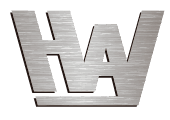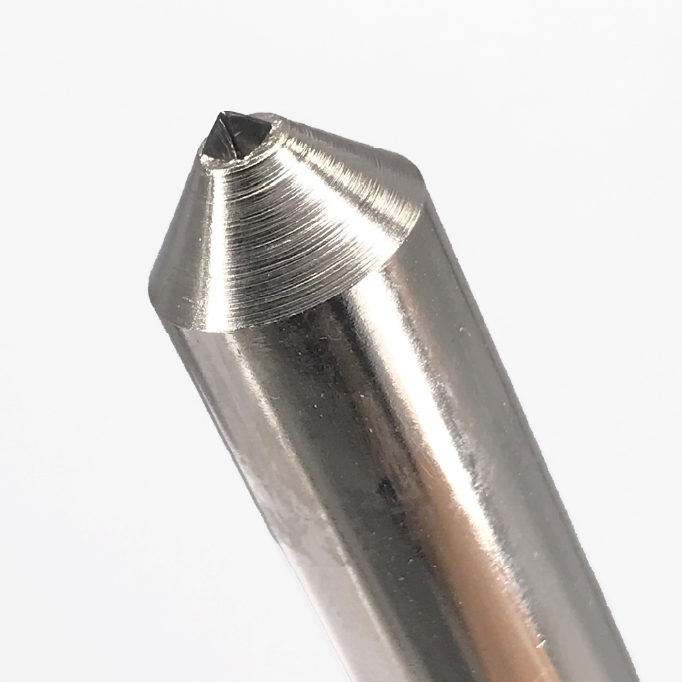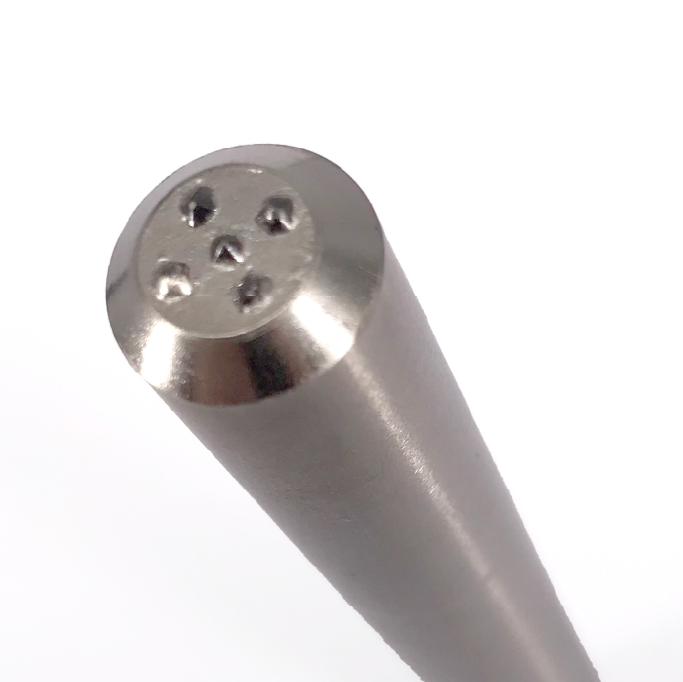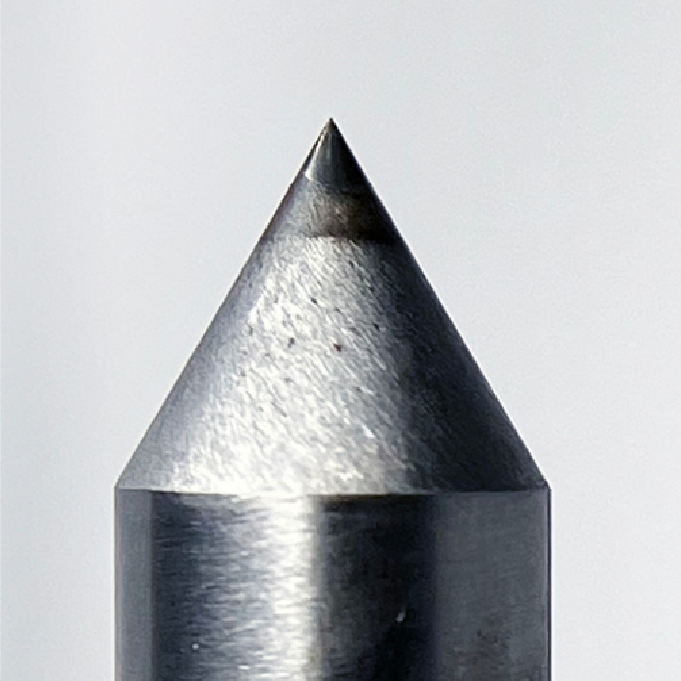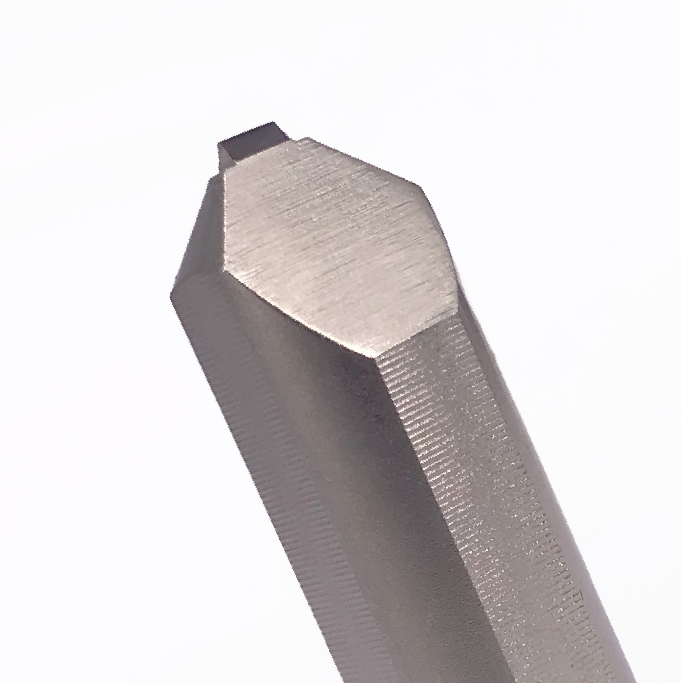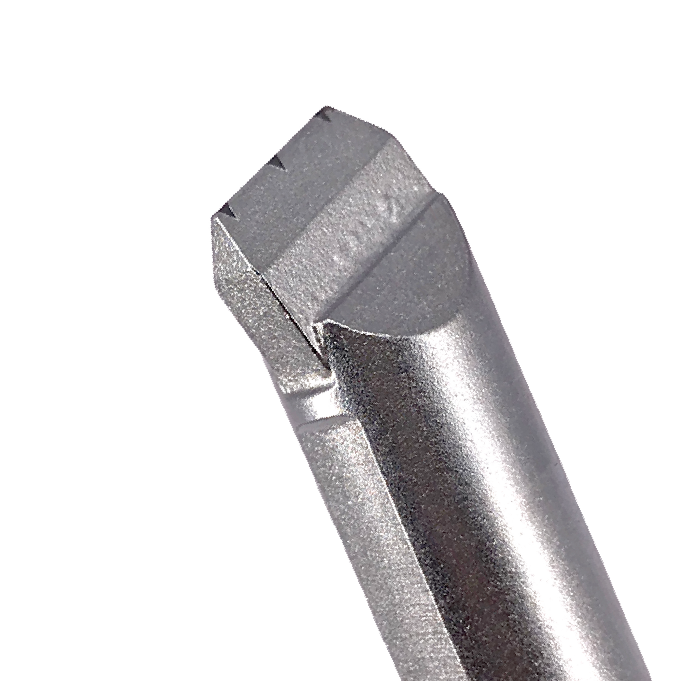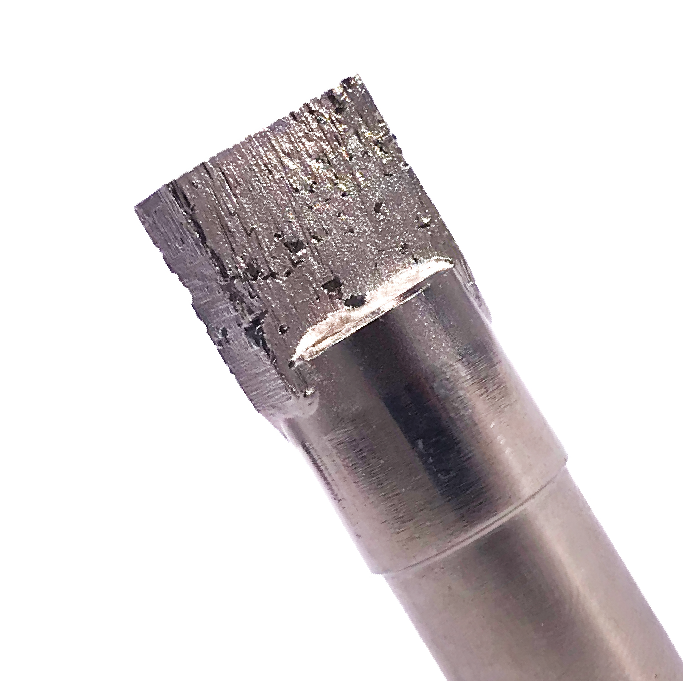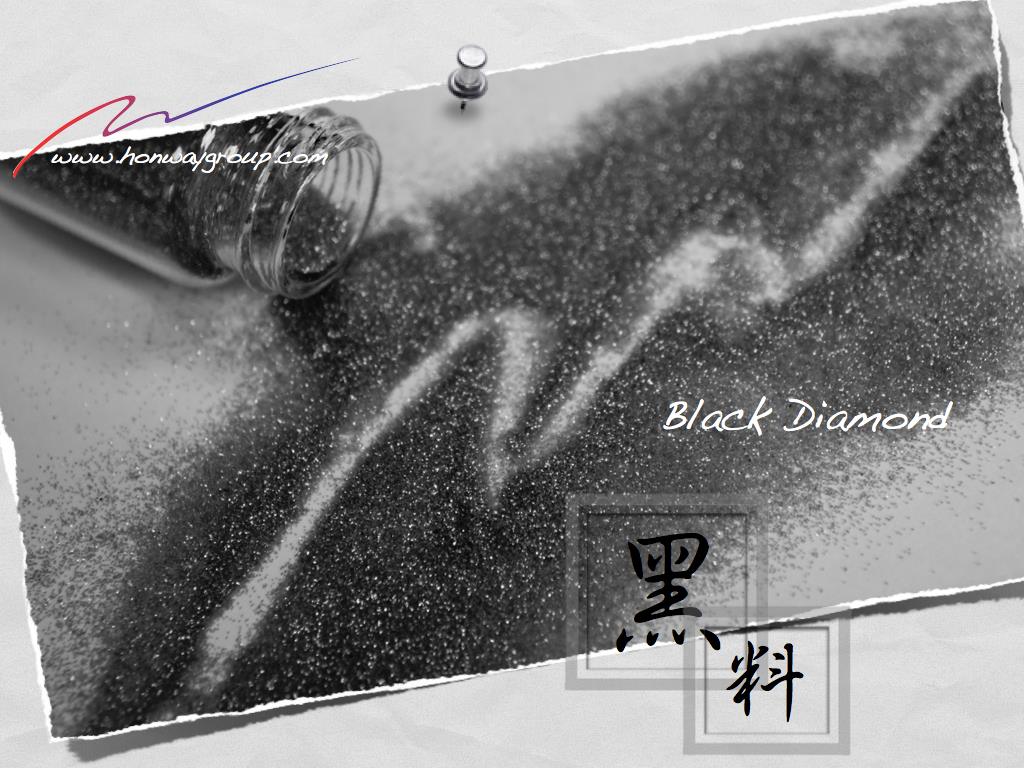In grinding processes, the performance and shape of the grinding wheel are crucial for machining quality and efficiency. However, as the usage time increases, the abrasive grains of the grinding wheel become dulled or clogged, affecting its cutting ability. Therefore, proper grinding wheel dressing (Truing & Dressing) is key to ensuring machining accuracy and stability.
The market offers a wide variety of dressing tools. Choosing the right dressing tool can not only restore the grinding wheel’s geometry but also maintain its cutting ability, improve machining efficiency, and extend the grinding wheel’s lifespan. This article will discuss how to choose the most suitable dressing tools from three aspects: grinding wheel size and material, required profile shape, and the quality of the diamonds in the dressing tool, to meet different machining needs.
Table of Contents
Truing and Dressing
Introduction to Truing
Truing refers to the process of reshaping the grinding wheel’s surface to achieve the required shape and flatness while ensuring concentricity with the wheel’s axis. A trued grinding wheel has a very smooth surface with relatively few protruding abrasive grains.
Introduction to Dressing
Dressing refers to the process of removing the bonding material surrounding the abrasive grains on the grinding wheel’s surface, allowing the sharp edges of the abrasive to be properly exposed, thereby restoring or enhancing the wheel’s grinding ability.
(Extended Reading: How to Choose Suitable Dressing Tools)
How to Choose Suitable Dressing Tools
We can choose suitable tools from the following three aspects:
- Grinding wheel size, bond type, and abrasive type
- Required shape and profile of the grinding wheel
- Quality of the diamonds in the dressing tool
1. Grinding Wheel Size, Bond Type, and Abrasive Type
Just like sculpting, to carve a desired shape or a specific surface on a grinding wheel, you must use a material harder than the grinding wheel. Diamond, currently the hardest known material, is therefore widely used in dressing tools.
The first step, understanding the grinding wheel’s size, bond type, and abrasive type, helps determine the required diamond carat weight (i.e., diamond size) for the dressing tool.Whether using single- or multi-point dressing tools, you should select the appropriate diamond size in the dressing tool based on the grinding wheel’s size, bond type, and abrasive characteristics.
Although diamonds are harder than grinding wheels, they still wear down during the dressing process. The extent of diamond wear depends on the contact time between the diamond and the grinding wheel. Therefore, larger grinding wheels generally require larger diamonds. In addition, larger diamond sizes are also recommended in the following situations:
- Grinding wheel thickness exceeds 6 inches: Longer contact time necessitates larger diamonds to enhance durability.
- Using resin-bonded grinding wheels: Compared with ceramic grinding wheels, resin bonds also affect the extent of diamond wear.
- Special abrasive grinding wheels (such as ceramic abrasives): Harder abrasives cause greater wear on diamonds, requiring higher diamond quality and size.
The following is a comparison table of grinding wheel outer diameter and dresser diamond size:
| Grinding wheel outer diameter | Recommended minimum diamond size |
| 8 inches or less(≦203mm) | 1/8 carat |
| 9~12 inches (204~304mm) | 1/4 carat |
| 13~20 inches (305~508mm) | 1/3 carat |
| 21~29 inches (509~736mm) | 1/2 carat |
| 30~36 inches (737~914mm) | 3/4 carat |
| 37 inches or more (≧915mm) | 1+ carat |
| Thickness ≧ 6 inches | Increase diamond size |
2. Required Shape and Profile of the Grinding Wheel
Different dressing tools are suitable for different grinding wheel shapes and profiles. For example:
- Simple dressing tools: Suitable for basic truing or arc-shaped truing. Examples: abrasive tools, blade-type tools, single-point dressers, cone-shaped dressers.
- Complex composite dressing tools: Used to create more complex shapes. Examples: blade-type tools, cone-shaped dressers.
Although the contact surface between the diamond tool and the grinding wheel may be small, choosing the right dressing tool can significantly impact machining benefits. ※Note: While most diamond tools can true straight or tapered profiles, specialized and shorter dressing tools should be used for complex profiles.
3. Quality of the Diamonds in the Dressing Tool
Diamond quality affects the price and lifespan of the dressing tool. Although there is no unified industry standard, it is generally believed that high-quality diamonds last longer. High-quality diamonds are characterized by:
- Fewer impurities, cracks, and flaws
- More precise shape and point
In addition, high-quality diamond tools (such as AA grade) can be resetting and relapping to further extend their service life:
- Resetting: Resharpening the diamond point to extend tool life.
- Relapping: Restoring the geometry and profile of the dresser to its original dimensions through mechanical means.
Although high-quality diamond tools are more expensive, their repairability and reusability can reduce long-term usage costs. In contrast, low-quality diamonds (such as D grade) cannot be reset. While they are cheaper, they may only be usable once and then need replacement.
How to Choose Between Dressing Tools and Bonds
Different bonds have different characteristics, and some dressers are not suitable for use with certain bonds. For example, single-crystal diamond dressers are not suitable for dressing metal-bonded grinding wheels. The high hardness and wear resistance of the grinding wheel can cause excessive wear, chipping, or dulling of the single-crystal diamond dresser, and may even lead to sintering.
| Resin | Metal | ceramics | Electroformation | |
| Metal Bond Diamond Dresser | + | ▲ | + | NA |
| Single-Point Diamond Dresser | ▲ | - | + | NA |
| Rotary Dresser | + | + | + | NA |
| Brake Dresser | + | + | - | NA |
| Emma Alloy (Soft Steel/Molybdenum Steel) | ▲ | - | - | NA |
| Electroplated/Metal Bond Diamond Block Tool | + | + | + | NA |
| Silicon Carbide Grinding Wheel Grinding | ▲ | + | - | NA |
The table above shows the suitability between commonly used dressing tools and bond types:
※Note:
- +: Recommended
- ▲: Can be used in some cases
- -: Not recommended
※Note: Electroplated bond grinding wheels have only a single layer and do not require truing or dressing.
Choosing the right tool can not only improve dressing efficiency and accuracy but also extend the tool’s lifespan.
What are some common dressing tools?
The top three most frequently used dressing tools are:
- Metal Bond Diamond Dresser
- Rotary Dresser
- Single-Point Diamond Dresser
The table below shows the proportion of commonly used dressing tools:
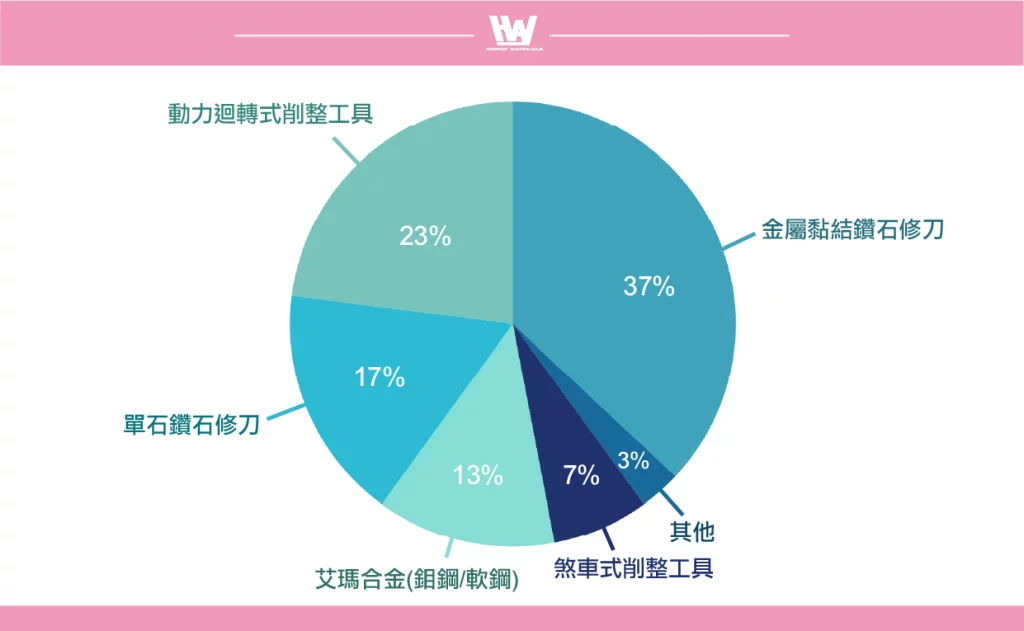
Common Dressing Tools
Natural Diamond Single-Point Dresser>>>Natural Diamond Single-Point Dresser
- Can be used for general dressing, truing, and dressing operations related to surface/cylindrical/centerless grinding.
- Suitable for: Dressing traditional grinding wheels.
- Not suitable for: Dressing diamond/CBN grinding wheels.
Multi-Stone Diamond Dresser>>>Multi-Stone Diamond Dresser
- ※Uses several smaller diamonds to simultaneously impact the grinding wheel, allowing the diamond dresser to perform dressing and truing operations on different grinding applications.
- ※New dressers need to be ground 3~5 times, removing about 0.005 inches, to expose the diamond portion.
- Suitable for: Large diameter grinding wheels or disc grinding wheels, centerless grinding, or large diameter grinding wheel dressing.
Conical Dresser>>>Conical Dresser
- ※Used for form dressing, or form dressing of internal and external arcs, form reduction of general silicon carbide and aluminum oxide grinding wheels, etc.
- Suitable for: Precision profile grinding dressing.
Profile Dresser>>>Profile Dresser
- Used for form dressing of grinding wheels, or form dressing of internal and external arcs.
- Suitable for: Precision profile grinding dressing.
CVD Profile Dresser>>>CVD Profile Dresser
- Used for form dressing of grinding wheels, or form dressing of internal and external arcs.
- ※Utilizes the sharp edges of three diamonds simultaneously to dress the grinding wheel, effectively improving dressing efficiency and grinding wheel accuracy. Also known as a Three-Point Dresser.
- Suitable for: Grinding wheels in aerospace, machine tool components, and automotive parts, etc.
Bonded Dresser>>>Bonded Dresser (DI Series)
- ※Due to the larger diamond contact area, dressing speed is faster.
- ※Can be used for both manual and automatic grinding wheel dressing.
- Suitable for: Large diameter grinding wheels or disc grinding wheels, centerless grinding, or large diameter grinding wheel dressing.
Conclusion
Choosing the right grinding wheel dressing tool requires considering the grinding wheel’s size and material, the required shape and profile, and the quality of the diamonds in the dressing tool. The appropriate dressing tool can effectively restore the grinding wheel’s cutting ability and shape, and improve machining accuracy and production efficiency.
In addition, the compatibility between the dressing tool and the grinding wheel bond is also a key factor. Improper selection may lead to excessive wear of the dressing tool or affect the machining results. For example, single-point diamond dressers are not suitable for metal-bonded grinding wheels because their high hardness can accelerate diamond chipping and wear.
Currently, the most common dressing tools on the market include metal bond diamond dressers, rotary dressers, and single-point diamond dressers, each with its own advantages and suitable for different machining needs. By selecting the appropriate dressing tool, not only can dressing efficiency and accuracy be improved, but also production costs can be effectively reduced and tool life extended.
Action
- How to choose grinding wheel>>>How to Choose Between Diamond Wheels and CBN Wheels?
- The Key Role of Grinding Wheel Performance>>Bond
- How to choose tools for cutting bonded grinding wheels>>How to Dress Grinding Wheels with Different Bond Type
- Is the current grinding wheel wear normally>>>What is the current status of the grinding wheel? – Electroplated Grinding Wheel Section
- How to dress a grinding wheel>>Grinding Wheel Dressing and Sharpening Methods
- Grinding wheel dressing in two stages>>What Are Truing and Dressing of Grinding Wheels?
- Different grinding states of cutting edge>>In-depth understanding of grinding wheel cutting edge shapes, variations, and self-sharpening mechanisms
- Implement>>Diamond and boron nitride grinding wheels, polishing abrasives, polishing equipment, polishing tools, diamond dressing tools
- How to dress different bonding agents>>How to Dress Grinding Wheels with Different Bond Types
- Review
We offer customized adjustments to the grinding process, tailored to meet processing requirements for maximum efficiency.
After reading the content, if you still don’t know how to select the most suitable option,
Feel free to contact us and we will have specialist available to answer your questions.
If you need customized quotations, you’re also welcome to contact us.
Customer Service Hours: Monday to Friday 09:00~18:00 (GMT+8)
Phone: +8867 223 1058
If you have a subject that you want to know or a phone call that is not clear, you are welcome to send a private message to Facebook~~
Honway Facebook: https://www.facebook.com/honwaygroup
You may be interested in…
[wpb-random-posts]
